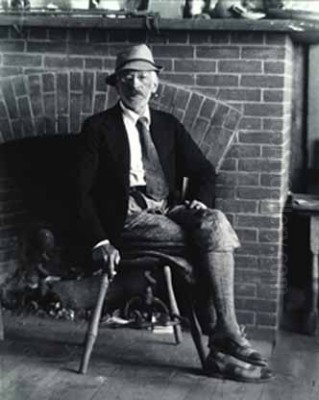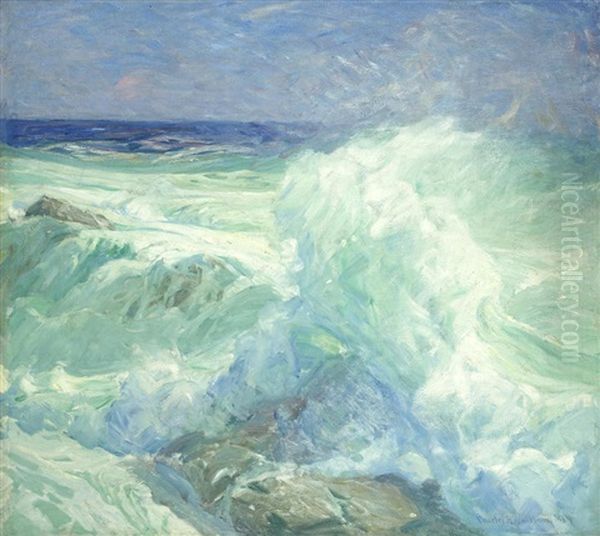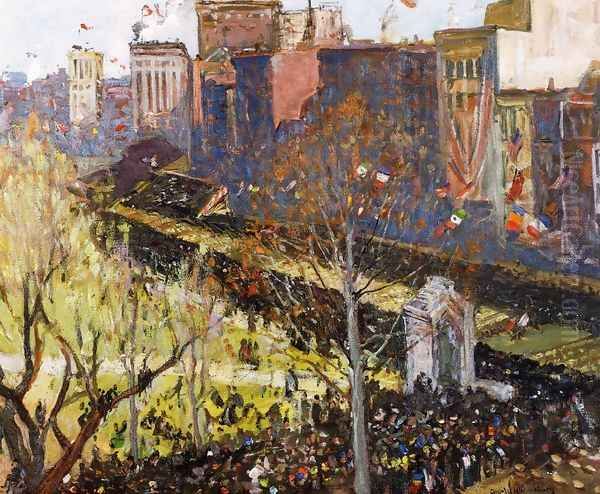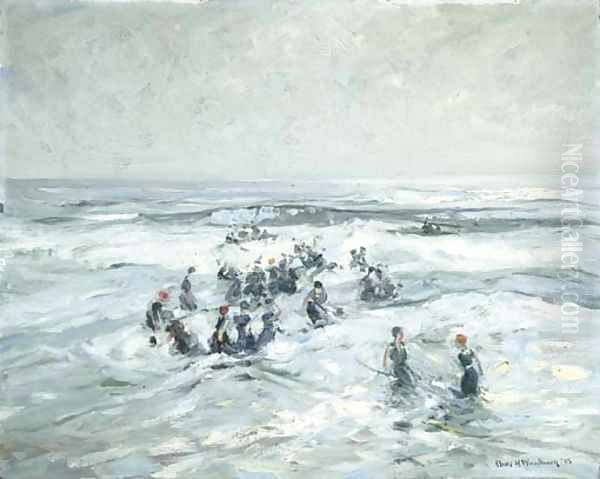
Charles Herbert Woodbury (1864-1940) stands as a significant figure in American art history, celebrated not only for his evocative marine paintings but also for his profound and lasting contributions as an art educator. Born in the maritime city of Lynn, Massachusetts, Woodbury's life and work were inextricably linked to the New England coast, whose power and beauty he captured with remarkable insight and dynamism. His dual legacy as a prolific artist and an influential teacher shaped the course of American art in the early twentieth century, inspiring generations of artists to look at and interpret the world with a fresh, analytical, and deeply personal vision.
Early Life and Artistic Awakening
Born on July 14, 1864, in Lynn, Massachusetts, Charles Herbert Woodbury demonstrated an early proclivity for the arts. The coastal environment of his upbringing undoubtedly played a crucial role in shaping his artistic sensibilities, instilling in him a lifelong fascination with the sea. His talent was apparent from a young age; he sold his first painting at the tender age of fifteen, a clear indication of his precocious abilities. By seventeen, his skills were so recognized that he became the youngest member of the prestigious Boston Art Club, an institution that played a vital role in the city's cultural life. This early recognition set the stage for a career dedicated to capturing the essence of the natural world, particularly the ever-changing moods of the ocean.
Woodbury's initial artistic development was nurtured in the rich cultural milieu of Boston. His early successes were not fleeting; they were built upon a foundation of keen observation and a burgeoning technical skill. The environment of Lynn, a city with a strong maritime heritage, provided him with endless subject matter. The ships, the coastline, the fishermen, and the dramatic interplay of light and water on the Atlantic became his first muses. This period was crucial for honing his observational skills and developing a personal connection to the subjects that would dominate his oeuvre.
Academic Pursuits and European Sojourns

Interestingly, Woodbury's formal higher education was not initially in art but in engineering. He attended the Massachusetts Institute of Technology (MIT), graduating in 1886 with a degree in Mechanical Engineering. This scientific and technical background, though seemingly disparate from an artistic career, likely contributed to his analytical approach to composition, his understanding of structure, and his keen interest in the mechanics of motion, particularly evident in his depictions of waves. It provided him with a unique lens through which to view and deconstruct the visual world.
Following his graduation from MIT, Woodbury's passion for art led him to pursue formal artistic training. He traveled to Paris, the epicenter of the art world at the time, to study at the renowned Académie Julian. There, he received instruction from influential academic painters Gustave Boulanger and Jules Joseph Lefebvre. The Académie Julian was a popular destination for American artists seeking to immerse themselves in European artistic traditions and contemporary movements. His time in Paris exposed him to a rigorous academic discipline, focusing on drawing, anatomy, and composition.
Woodbury also studied under the American artist Ross S. Turner, who was known for his watercolors and marine paintings. This mentorship would have been particularly relevant to Woodbury's developing interest in maritime subjects. Furthermore, Woodbury spent time in Holland, where he immersed himself in the study of modern Dutch painters. The Dutch artistic heritage, with its strong tradition of landscape and marine painting, and its emphasis on light and atmosphere, would have resonated deeply with Woodbury's own artistic inclinations. These European experiences broadened his artistic horizons, refined his technique, and exposed him to diverse artistic philosophies.
The Call of the Coast: Artistic Focus
Upon his return to the United States, Woodbury settled in New England and began to establish himself as a prominent marine painter. His deep-seated connection to the coast, cultivated since his childhood in Lynn, became the central theme of his artistic output. He possessed an uncanny ability to capture the raw power, majestic beauty, and subtle nuances of the ocean and the rugged New England shoreline. His paintings were not mere topographical representations; they were imbued with emotion, energy, and a profound understanding of the sea's dynamic character.

His works from this period demonstrate a growing mastery of his medium, whether oil or watercolor. He was particularly adept at depicting the movement of water, the crash of waves against rocks, the play of light on the ocean surface, and the atmospheric effects of coastal weather. Artists like Winslow Homer had already established a strong tradition of American marine painting, and Woodbury built upon this legacy, bringing his own unique perspective and technical prowess to the genre. His engineering background may have informed his almost scientific observation of wave mechanics, yet his execution was always expressive and painterly.
Woodbury's reputation grew steadily, and his works began to be exhibited and collected. He was drawn to the dramatic landscapes of the Maine coast, which offered a wealth of inspiration. The powerful Atlantic, the rocky shores, and the ever-changing skies provided an endless source of subject matter that challenged and excited him. He was not content to simply record what he saw; he sought to convey the experience of being by the sea, its sounds, its movement, and its overwhelming presence.
The Ogunquit School of Painting: A Revolutionary Approach
In 1897, Charles Herbert Woodbury, alongside his wife, the artist Marcia Oakes Woodbury, and later with the involvement of artist Hamilton Easter Field, founded the Ogunquit School of Painting in the small fishing village of Ogunquit, Maine. This summer school quickly became one of the most important and influential art schools in America, attracting thousands of students from across the country over its many decades of operation. Ogunquit, with its picturesque harbor, dramatic cliffs, and sandy beaches, provided an ideal outdoor studio for aspiring artists.
The Ogunquit School was more than just a place to learn technique; it was a vibrant artistic community where Woodbury disseminated his unique teaching philosophy. He encouraged his students to move beyond mere imitation and to engage with their subjects on a deeper, more intellectual and emotional level. The school's success transformed Ogunquit into a thriving art colony, a status it maintained for many years, drawing other notable artists to the area, including Edward Hopper, George Bellows, and Robert Henri, who were associated with the school or the colony at various points.
Woodbury's approach to teaching was considered revolutionary for its time. He emphasized direct observation from nature, but he also stressed the importance of memory, imagination, and personal interpretation. He believed that art was a mental activity as much as a physical one. His summer painting and printmaking courses became legendary, and his influence extended far beyond the students who directly attended his classes, through his writings and the work of his pupils. The school's legacy is a testament to Woodbury's vision as an educator and his ability to inspire creative thought.
Woodbury's Artistic Philosophy: "Painting with Verbs"

Central to Woodbury's teaching was his famous dictum: "Paint in verbs, not in nouns." This seemingly simple phrase encapsulated a profound artistic philosophy. He urged his students to focus on the action, movement, and forces inherent in a scene, rather than merely depicting static objects. For Woodbury, a wave was not just a "noun" (a thing) but a "verb" (an action – crashing, rolling, receding). This approach encouraged a more dynamic and expressive form of representation.
He taught that art was not about copying nature but about interpreting it, imbuing it with life, emotion, and intellectual understanding. "Art is the expression of an idea in terms of a medium," he often stated, emphasizing the intellectual process behind artistic creation. Observation was paramount, but it was an active, analytical observation. He encouraged students to "see big," to grasp the essential character and underlying structure of a subject before getting lost in superficial details. This meant understanding the forces at play – the weight of a rock, the thrust of a wave, the bend of a tree in the wind.
His teaching methods were designed to develop the student's capacity for critical seeing and personal expression. He believed that an artist's emotional response to a subject was a crucial component of the creative process. "The subject is merely the peg on which you hang your emotion," he would say. This emphasis on personal feeling and intellectual engagement distinguished his pedagogy and had a lasting impact on his students, many of whom went on to become significant artists in their own right. His philosophy encouraged a sense of immediacy and vitality in painting.
Mastering the Mediums: Oil, Watercolor, and Etching
Charles Herbert Woodbury was a versatile artist, proficient in several mediums, though he is perhaps best known for his oils and watercolors. His oil paintings often convey the power and drama of the sea with rich textures and bold brushwork. He was able to capture the solidity of coastal rock formations and the fluid energy of breaking waves with equal conviction. His understanding of color and light allowed him to depict the myriad moods of the ocean, from tranquil calms to raging storms.
In watercolor, Woodbury demonstrated a remarkable fluidity and transparency. This medium was particularly well-suited to capturing the fleeting effects of light and atmosphere along the coast. His watercolors often possess a luminous quality and a sense of spontaneity. He produced a significant body of work in watercolor during his travels, including to the Caribbean, where he depicted beaches, towns, mountains, and cloud formations with characteristic vibrancy.
Beyond painting, Woodbury was also an accomplished etcher, producing over 500 prints during his career. His etchings often explored the same maritime themes as his paintings, but the linear quality of the medium allowed for a different kind of expression. He skillfully used line to convey form, texture, and movement, creating images that were both delicate and powerful. His mastery across these different mediums speaks to his deep understanding of artistic principles and his relentless exploration of visual language. His technical skill was always in service of his expressive aims, allowing him to communicate his vision with clarity and force.
Signature Works and Their Characteristics
Among Charles Herbert Woodbury's many works, several stand out as representative of his artistic vision and style. "The Breaker" is a quintessential Woodbury marine, capturing the dynamic force of a wave as it curls and crashes. Such paintings exemplify his "paint in verbs" philosophy, focusing on the motion and energy of the water. Works like "Stormy Day at the Docks" (or similar titles depicting harbor scenes in inclement weather) showcase his ability to convey atmospheric conditions and the robust character of coastal life.
Paintings such as "House by the River" demonstrate his versatility in landscape, moving beyond the immediate coastline to capture the broader New England environment. A piece like "Victory Parade, Boston, April 25, 1919" shows his engagement with contemporary events, rendered with an observational acuity. "Snow Shadows" would highlight his ability to capture the subtleties of light and form in different seasons and conditions, while a "Dutch Canal Scene" reflects his European studies and his interest in varied landscapes and architectural elements.
The common thread in these diverse subjects is Woodbury's commitment to capturing the essential truth of the scene, filtered through his personal perception and emotional response. His works are characterized by strong compositions, a keen sense of light and color, and an emphasis on movement and vitality. He avoided sentimentality, instead imbuing his subjects with a sense of dignity and power. His brushwork could be both controlled and expressive, adapting to the specific demands of the subject matter.
A Circle of Influence: Contemporaries and Connections
Charles Herbert Woodbury operated within a vibrant American art scene and was connected, either directly or contextually, with many prominent artists of his era. His Ogunquit School naturally brought him into contact with numerous artists. Among his students or those associated with the Ogunquit art colony were figures who would achieve significant fame, such as Edward Hopper, known for his poignant depictions of American solitude, and George Bellows, a key member of the Ashcan School celebrated for his dynamic urban scenes and boxing paintings. Robert Henri, a leading figure of the Ashcan School and an influential teacher himself, also had connections to Ogunquit.
Woodbury maintained a close friendship with the renowned portraitist John Singer Sargent, whose painterly bravura and keen observational skills would have found resonance with Woodbury's own artistic pursuits. He was also a contemporary of Winslow Homer, America's preeminent marine painter of the late 19th century. While their styles differed, both artists shared a profound respect for the power of the sea and a dedication to depicting it with honesty and vigor. Woodbury's co-founder of the Ogunquit colony, Hamilton Easter Field, was an artist, critic, and collector who played a significant role in promoting modern art in America.
The artistic environment of Boston, where Woodbury began his career, was also home to the Boston School of painters, including American Impressionists like Childe Hassam (though more broadly active), Frank W. Benson, and Edmund Tarbell. While Woodbury's style leaned more towards a dynamic realism, he would have been aware of and likely interacted with these artists. His own teacher, Ross S. Turner, was a respected Boston artist. Furthermore, in the broader field of marine painting, artists like Frederick Judd Waugh were also gaining prominence for their dramatic seascapes. Woodbury's work and teaching thus contributed to a rich dialogue within American art, influencing and being influenced by the diverse currents of his time. His unique approach, however, carved out a distinct niche for him.
Awards, Recognition, and Institutional Affiliations
Throughout his career, Charles Herbert Woodbury received numerous accolades and held respected positions within the art community, reflecting the high esteem in which he and his work were held. His paintings were frequently exhibited in major national and international shows. A significant recognition came at the 1915 Panama-Pacific International Exposition in San Francisco, where he was awarded a gold medal for his oils and an honor medal for his watercolors, a testament to his mastery in multiple mediums.
His leadership qualities and dedication to the arts were also recognized by his peers. Woodbury served as the president of the Boston Water Color Society, a prominent organization that promoted the medium and showcased the work of its members. Furthermore, he was elected an academician of the National Academy of Design in New York, one of the highest honors for an American artist, signifying his national standing and contribution to the arts.
His works were sought after by major museums and private collectors. Today, his paintings and etchings are held in the permanent collections of numerous prestigious institutions, including the Museum of Fine Arts, Boston; the Art Institute of Chicago; the Metropolitan Museum of Art, New York; and the Fogg Art Museum at Harvard University, among others. This widespread institutional recognition underscores the enduring quality and importance of his artistic output.
Legacy in Print: Sharing His Vision
Beyond his direct teaching at the Ogunquit School and other institutions like Wellesley College and Dartmouth College, Charles Herbert Woodbury extended his educational influence through his writings. He authored three influential books that articulated his artistic philosophy and teaching methods, allowing his ideas to reach a wider audience and to endure beyond his lifetime.
His first book, Painting and the Personal Equation (1919), explored the subjective and intellectual aspects of art-making, emphasizing the role of the artist's individual perception and emotional response. This was followed by Observation: Visual Training Through Drawing (1922), co-authored with Elizabeth Ward Perkins, which detailed practical methods for developing observational skills, crucial for any aspiring artist. His final book, The Art of Seeing: Mental Training Through Drawing (1925), further elaborated on his ideas about visual perception and the cognitive processes involved in creating art.
These publications codified his teaching principles, such as "painting with verbs" and "seeing big," and provided a theoretical framework for his practical instruction. They remain valuable resources for understanding his approach to art and art education, and they demonstrate his commitment to articulating a clear and thoughtful pedagogy. Through these books, Woodbury's voice as an educator continues to resonate, offering insights into the creative process that remain relevant for artists today.
Final Years and Lasting Impact
Charles Herbert Woodbury remained dedicated to his art and teaching throughout his life. He continued to paint and exhibit, and the Ogunquit School flourished under his guidance. He passed away on January 21, 1940, in Boston, Massachusetts, leaving behind a rich legacy as both a creator and an educator. His influence on American art, particularly in New England, was profound and multifaceted.
The impact of his teaching was felt by the thousands of students who passed through the Ogunquit School. Many of them went on to have successful careers as artists and educators, carrying Woodbury's principles forward. The school itself became a cornerstone of the Ogunquit art colony, contributing to the region's reputation as a significant center for American art. His emphasis on dynamic expression, intellectual engagement, and keen observation offered a compelling alternative to purely academic or imitative approaches to art.
His marine paintings continue to be admired for their power, authenticity, and artistic skill. They capture a vital aspect of the American experience – the nation's relationship with the sea – and they do so with a unique blend of analytical understanding and expressive force. Woodbury's work serves as an important link in the tradition of American marine painting, standing alongside that of masters like Winslow Homer and influencing subsequent generations of artists who have been drawn to the sea as a subject.
Reappraising Woodbury: Historical Evaluation and Modern Relevance
In the decades since his death, Charles Herbert Woodbury's contributions have been subject to ongoing historical evaluation. While perhaps not as widely known to the general public as some of his contemporaries like Hopper or Bellows (who were, in part, his students or associates), his significance within art historical narratives, particularly concerning art education and marine painting, is undeniable. Curators and scholars have increasingly recognized the innovative nature of his teaching and the enduring quality of his artwork.
Retrospectives and exhibitions of his work continue to be organized, allowing new audiences to discover his powerful seascapes and insightful landscapes. His emphasis on "seeing big" and understanding the underlying forces in nature resonates with contemporary concerns about ecological awareness and the human relationship with the environment. His teaching philosophy, which stressed critical thinking, personal expression, and the integration of emotion and intellect, remains highly relevant to art education today.
The presence of his works in major museum collections across the United States ensures that his artistic achievements are preserved and accessible for study and appreciation. Charles Herbert Woodbury's legacy is that of a master painter who captured the spirit of the New England coast with unparalleled vigor, and an equally gifted educator who empowered countless artists to find their own creative voices. He remains a pivotal figure in the story of American art, a testament to the enduring power of a life dedicated to the intertwined pursuits of creation and instruction.